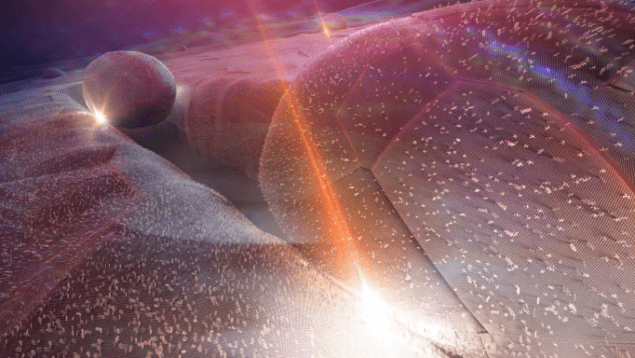Frequency upconversion makes infrared light visible
07 Jan 2022
A new way of converting infrared light into visible wavelengths could make it possible to detect and measure mid-infrared signals using cheap and efficient sensors like those found in mobile phone cameras. The method, which was developed independently by two teams of researchers, could have applications in areas as diverse as personalized medicine, environmental monitoring and security.
Although many molecules emit light in the infrared region of the electromagnetic spectrum, detecting these low-energy spectroscopic “signatures” usually requires expensive cryogenically cooled equipment. In contrast, detecting visible light is relatively straightforward – so much so that even a smartphone camera is good enough to have spectroscopic applications.
In the latest work, international collaborations led by Christophe Galland of the EPFL in Switzerland and Jeremy Baumberg of the University of Cambridge, UK “upconverted” infrared light to visible wavelengths using optomechanical techniques. Both groups began by creating a nanocavity around 1 nm wide and placing a single layer of biphenyl-4-thiol (BPT) molecules within it. These molecules have a vibrational mode that is excited by mid-infrared (MIR) light, and the presence of the cavity facilitates strong light-matter interactions, creating plasmonic resonances that enhance and support both MIR and visible light.
The next step is to detect the vibrational mode by using a separate beam of visible light to perform Raman spectroscopy, which is an optical scattering technique that measures inelastically scattered photons. The energy of the vibrational mode is then measured directly from the frequency shift in the photons when they lose energy (Stokes shift) or gain energy (anti-Stokes shift) from the scattering. Finally, the strength of the MIR can be read out from the intensity of the anti-Stokes emission.
Nanocavity designs
The two teams’ techniques differ chiefly in the construction of their nanocavities and the nature of the lasers used to excite and detect the vibrational mode. Galland and colleagues created their nanocavity by placing a gold nanoparticle around 150 nm in diameter inside a groove that is etched in a gold film covered by a monolayer of BPT. The presence of the monolayer creates a 1 nm gap between the two gold surfaces that acts as a nanocavity. The infrared resonance frequency is governed by the length of the nanogroove and was chosen as 2 µm to match a vibrational mode of the BPT molecule. The EPFL team used a continuous wavelength laser with an input wavelength of 9.3 µm to excite the BPT, while focusing a second laser tuned to 740 nm onto the sample to measure the anti-Stokes shift.
Baumberg and colleagues, for their part, created their nanocavity using gold discs around 6 µm in diameter that had been deposited onto silicon wafers. The discs were then covered with the BPT monolayer, and a gold nanosphere around 60 nm in diameter placed on top, again forming a 1 nm gap. To generate MIR light, the Cambridge team used a pulsed laser source with an adjustable wavelength of between 8 and 12 µm, tuned to match a vibrational mode of the BPT molecule. The team used a 785 nm laser source for Raman excitation and to collect anti-Stokes shift spectral lines.
On a different wavelength
According to Galland, the two groups’ results demonstrate that combining mid-infrared excitation and Raman spectroscopy on the same nanocavity is a versatile technique, one that works on different nanocavity designs. The biggest difference, he says, is that the Cambridge team uses a pulsed light source, meaning that the peak power impinging on the nanocavity is significantly higher. From the data provided in the other team’s paper, which is published in the same issue of Science as the EPFL result, Galland says he finds it plausible that the upconversion process was not fully coherent, and that thermal effects could have contributed to it, which might reduce the range of applications. The tuneability of the pulsed laser does, however, make it possible to verify which molecular vibrations permit upconversion, which Galland says is an advantage.
In Baumberg’s view, both results represent a big contribution to the field and could lead to practical applications. “This is a very new way to detect mid-infrared light without having to cool detectors, which is what you normally need to do if detecting low-energy mid-infrared photons directly,” he says. However, he suggests that the lack of smooth surfaces in the EPFL team’s cavity could be a stumbling block. “This [uneven surface] traps light differently, and indeed such systems are harder to reproduce,” he explains. “We use nanoparticles on flat gold, and the strong van-der-Waals attraction of over 200 atmospheres between the metal surfaces anneals the gold facets atomically flat. This helps us get extremely consistent results.”
A bright infrared future
In the future, Galland’s team plans to focus on increasing the number of molecules that contribute to the upconversion. In principle, improvements in conversion efficiency of many orders of magnitude are possible, he says, and the team is exploring several routes to achieve this. Another area of improvement would be to expand spectral coverage across the mid-infrared and down to the THz domain. “Together with chemists and theorists, we are identifying and designing molecules that support vibrational modes with the required properties for upconversion at lower frequencies (longer wavelengths),” he says. “We are also exploring different other designs for dual-resonance plasmonic cavities with improved characteristics and scalability.”READ MORE

Baumberg’s team is currently focusing on developing better molecules, better mid-infrared antennas, better visible light detection and more compact designs to make the system more practical. In his view, the “right” molecule to use for upconversion is still an open question. While the current two-benzene-ring system is the most stable he and his colleagues have studied over the past six years, they are now using machine learning to explore several million other options – making the effort a truly interdisciplinary collaboration between experts in nano-optics, electromagnetic theory and molecular quantum modelling.
from physicsworld.com 7/1/2022

Δεν υπάρχουν σχόλια:
Δημοσίευση σχολίου